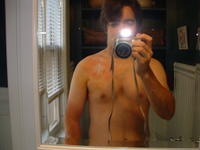
How it all started…
The cardiologists told us that Dave was a healthy teenager, and his heart was strong and normal. They were at a loss to explain why it spontaneously developed an arrhythmia. But the digoxin, to help prevent further occurrences, and follow-up visits, reassured us and Dave went home and picked up life exactly where he’d left off three days earlier.
Six months later, during his follow-up visit, the doctor noticed a unique wave pattern in Dave’s ECG. We learned that day the Dave most likely had Brugada Syndrome. It's rare, and isn’t usually associated with cardiac arrhythmias or flutters. How fortunate we were, that Dave was under the care of cardiologists with the skill to notice this elusive condition. The gave us sobering news: if Dave did have Brugada Syndrome, he was at risk of experiencing sudden cardiac death at any time.
Brugada Syndrome is usually confirmed during an electrophysiology study (EP study) in which a catheter is threaded from a large vein in the groin to the heart. Here electrical activity can be studied and any arrhythmias can be mapped. The ventricle (lower chamber) is then prodded into fibrillation in a controlled setting. A healthy heart will not go into fibrillation. Another method that can be employed is to introduce certain drugs to stimulate fibrillation.
Dave went through the EP study, which confirmed his diagnosis. Before we had begun to absorb what was happening, he was scheduled for next day surgery to have an ICD (implantable cardioverter defibrillator) installed. This seems like a drastic step to take because the surgery is invasive and the ICD is costly. But we learned that there is no cure for Brugada Syndrome. The ICD will shock Dave’s heart back into sinus rythym if he has a Brugada event. Since Dave was at risk of sudden cardiac death, the choice here was simple. His ICD is the only assurance we have that Dave will survive such an event. At the top of this post is a picture of Dave taking a photo of his incision site the day he returned home from the hospital with his ICD.
The story doesn’t end here. Brugada Syndrome is hereditary. Our whole family was tested, and blood drawn for genetic study. My daughter and I showed no characteristic waves in our ECG strips, but Dave’s father, Jim, was found to have the syndrome. He, too, endured the EP study, and the subsequent surgery to have an ICD implanted. During the EP study was able to have an existing atrial arrhythmia condition treated successfully through a procedure called cardiac ablation, and this was good.
The doctor told my daughter that because her genetic make-up is identical to her brother's, she should have a new ECG strip run every now and then and sent to him for review just in case. Another confounding element of Brugada Syndrome is that is doesn't present in an ECG every time, it may appear and disappear over a person's lifetime.
2 comments:
Hi Ginny,
Read your story-so glad you're all doing well. My son, Alex was found to have a bugada-type ECG last week. He had an ECG done because he had started on a medication and the doc wanted to make sure his baseline ECG was normal. He is clinically asymptomatic (no syncope or aborted SCA) and there is no history of SCA on my and my husbands sides of our families. We now are taking Alex to a cardiologist in NYC to have a procainamide challenge test. As a nurse myself, I find the whole thing frightening and unbelievable.
But we are trying to down play it for our son and our 4 other teenaged boys. If Ales'x test is positive, we will then get genetic testing because my other sons may be positive as well.
How did your son take to his ICD? Has he had any misfirings?
BJ
Hi BJ,
I'm sorry if you posted your comment a long time ago. I have not been as conscientious about updating this blog as I should be! My son is doing fine. He continues to exhibit the characteristic Brugada Syndrome pattern in his ekg studies, but he has not had an "event" in which his heart beat erratically, nor has his ICD misfired. He does have the recalled lead, but did not have it replaced. So far, no problems. I hope things are going well for you. Let me know what has happened since you posted.
Post a Comment